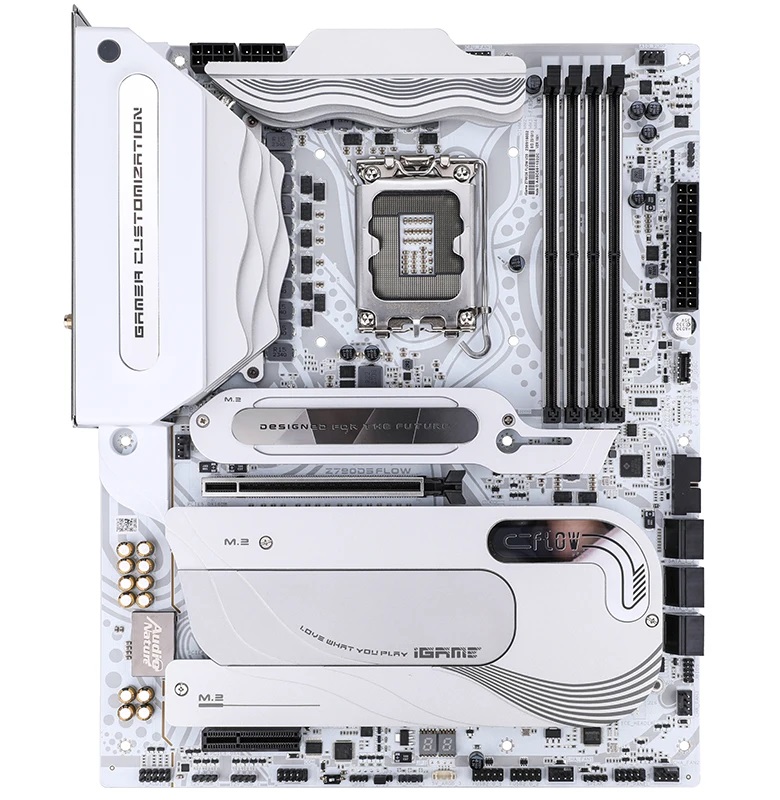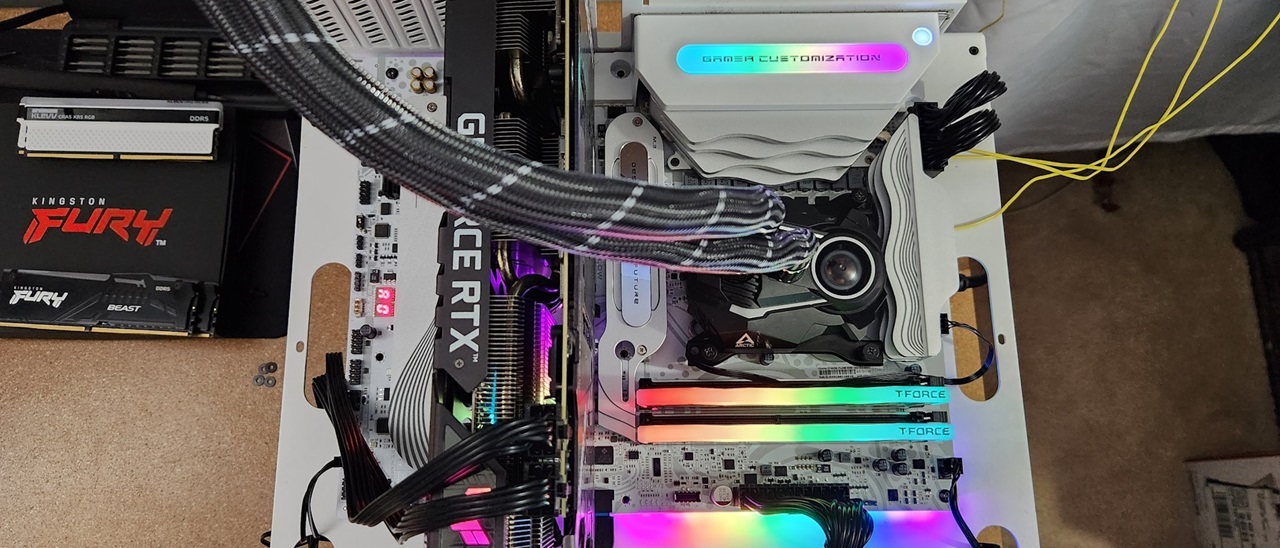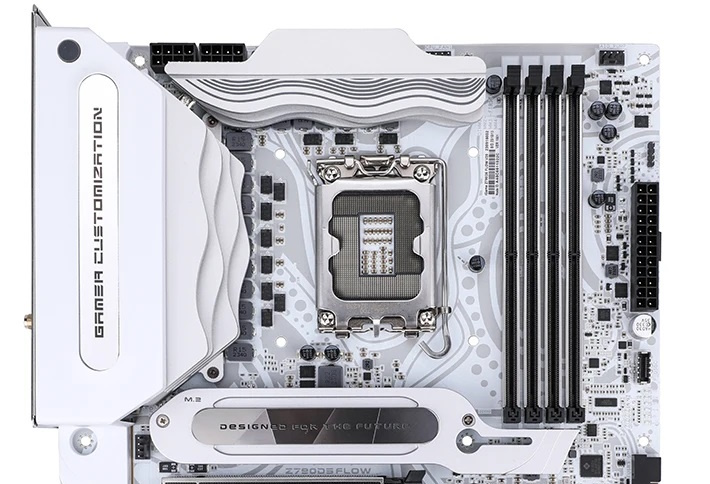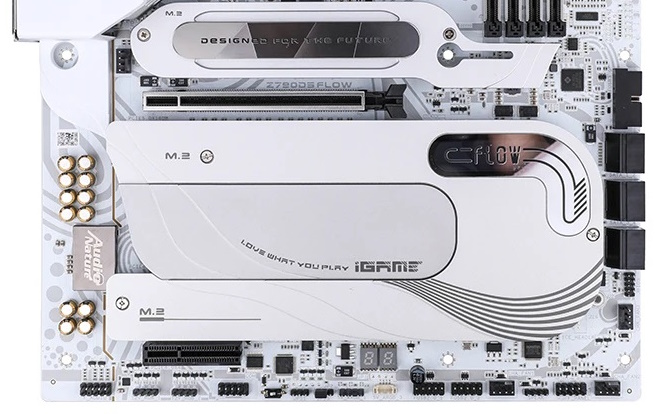Tom's Hardware Verdict
For just under $400, the IGame Z690D5 Flow is a valid option in the packed mid-range space. While it’s missing a PCIe 5.0-capable M.2 socket, it is an otherwise well-rounded option with good performance. The rare white PCB and flowing lines on the heatsinks provide a unique look that stands out inside your chassis.
Pros
- +
Unique white ‘flowing’ appearance
- +
Good performance in our test suite
Cons
- -
Lacks PCIe 5.0 capable M.2 socket
- -
Dated integrated video outputs
Why you can trust Tom's Hardware
The latest board to land on our testbench comes from Colorful, a company thats been churning out products in China for over 20 years. This includes graphics cards (where they claim to hold the largest market share) from 1999 and motherboards from 2002. Fast forward to today and we have the iGame Z790D5 Flow ready for our benchmark suite.
It stands out from most other boards by sporting a white and silver appearance and unique wavy heatsink shapes – hence the Flow in the product name. Hardware-wise, the board has almost everything the Z790 platform offers, including 14th-gen support (with supported BIOS), robust power delivery, ample storage options, fast networking, and more– just no PCIe 5.0 SSD socket.
Colorful has a comprehensive set of motherboards for Z790 - a total of eight. There’s the premium iGame series (Z790D5 Flow and Z790D5 Ultra), the mid-range CVN series (six boards, including two Micro ATX offerings), and finally the more budget Battle-AX series (both Micro ATX). For those more interested in price than overclocking, the company also has several B760-based motherboards (10 to be exact). The only thing missing is a Mini-ITX board. Otherwise, there’s something for everyone in Colorful’s product stack.
The Z790D5 Flow three RGB elements (VRM, chipset, and right corner from below) that will brighten your chassis and room. Hiding under all the shrouds and heatsinks are four M.2 sockets, a last-gen flagship audio solution, multiple PCIe slots (including one PCIe 5.0), and six SATA ports. There are plenty of USB ports out back as well, including a 20 Gbps USB 3.2 Gen 2x2 Type-C port, and the front Type-C port supports PD3.0 30W charging capability.
Performance in our test suite proved the board could handle the full power of our Intel i9-14900K no matter what we threw at it. Like most Z790 motherboards, this one is limited by the cooling and thermal throttling, not the power delivery. Both productivity and gaming showed promising results, especially with the Procyon video and photo editing, which led the pack.
Below, we’ll dig into the details of the board and see how it performs with our flagship-class Core i9-14900K processor and against a few other new Z790 motherboards. Will it make our best motherboard list? Read on to find out, but before we get into that, we’ll start by listing the specifications from the Colorful website.
Specifications: Colorful iGame Z790D5 Flow
| Socket | LGA1700 |
| Chipset | Z790 |
| Form Factor | ATX |
| Voltage Regulator | 20 Phase (18x 90A SPS MOSFETs for Vcore) |
| Video Ports | (1) DisplayPort (v1.2) |
| Row 5 - Cell 0 | (2) HDMI (v2.0) |
| USB Ports | (1) USB 3.2 Gen 2x2 Type-C (20 Gbps) |
| Row 7 - Cell 0 | (3) USB 3.2 Gen 2 (10 Gbps) |
| Row 8 - Cell 0 | (2) USB 3.2 Gen 1 (5 Gbps) |
| Row 9 - Cell 0 | (4) USB 2.0 (480 Mbps) |
| Network Jacks | (1) 2.5 GbE |
| Audio Jacks | (5) Analog + SPDIF |
| Legacy Ports/Jacks | ✗ |
| Other Ports/Jack | ✗ |
| PCIe x16 | (1) v5.0 x16 |
| Row 15 - Cell 0 | (1) v4.0 x4 |
| PCIe x8 | ✗ |
| PCIe x4 | (1) v4.0 x4 |
| PCIe x1 | (1) v3.0 x1 |
| CrossFire/SLI | ? |
| DIMM Slots | (4) DDR5 7800+(OC), 192GB Capacity |
| M.2 Sockets | (1) PCIe 4.0 x4 (64 Gbps) / PCIe (up to 110mm) |
| Row 22 - Cell 0 | (2) PCIe 4.0 x4 (64 Gbps) / PCIe (up to 80mm) |
| Row 23 - Cell 0 | (2) PCIe 4.0 x4 (64 Gbps) / PCIe + SATA (up to 80mm) |
| Row 24 - Cell 0 | Supports RAID 0/1/5/10 |
| SATA Ports | (4) SATA3 6 Gbps (Supports RAID 0/1/5/10) |
| USB Headers | (1) USB v3.2 Gen 1, Type-C (5 Gbps) |
| Row 27 - Cell 0 | (1) USB v3.2 Gen 1 (5 Gbps) |
| Row 28 - Cell 0 | (2) USB v2.0 (480 Mbps) |
| Fan/Pump Headers | (6) 4-Pin (CPU, System, watercooling fans) |
| RGB Headers | (2) aRGB (3-pin) |
| Row 31 - Cell 0 | (2) RGB (4-pin) |
| Row 32 - Cell 0 | (1) ARGB expansion socket |
| Diagnostics Panel | (1) 2-character Debug LED |
| Row 34 - Cell 0 | (1) Debug LEDs (4 LEDs) |
| Internal Button/Switch | RGB on/off switch |
| SATA Controllers | ✗ |
| Ethernet Controller(s) | (1) Realtek RTL8125BG (2.5 GbE) |
| Wi-Fi / Bluetooth | Wi-Fi 6E AX211 (2x2 be, MU-MIMO, 160 MHz, BT 5.2) |
| USB Controllers | ✗ |
| HD Audio Codec | Realtek ALC1220 |
| DDL/DTS | ✗ / ✗ |
| Warranty | 3 Years |
Inside the Box of the iGame Z790D5 Flow
The motherboard includes several accessories to help get you going without an unexpected trip to the store. Inside, you get the usual fare, including RGB extensions, SATA cables, a manual, and more. The drivers come on an included USB stick, a nice touch. Also inside the box is a screwdriver tool kit to help with the build. Below is a complete list of the included accessories.
- Motherboard operation guide
- USB stick for drivers
- (3) RGB extension cables
- Wi-Fi antenna
- iGame Stickers
- (4) SATA cables (white)
- (3) M.2 screws
- Tool/Screwdriver kit
Design of the Z790D5 Flow



The Z790D5 Flow’s appearance, from the white PCB to the uniquely wavy look of the VRM heatsinks, is going to garner attention inside your chassis. Instead of the sharp lines we’re used to seeing, the edges of most heatsinks and shrouds are rounded off for a one-of-a-kind design. The board also has a light gray pattern to break up the monotony. If the white look isn’t enough, there are also three RGB zones (VRM, chipset, and underneath along the right edge) to help set off the design. Overall, we like how the board looks, and the curvy design truly stands out compared to the competition.
Get Tom's Hardware's best news and in-depth reviews, straight to your inbox.
In the top left corner, the starting point of our tour, we run into two 8-pin EPS connectors (one required) to power the processor. Below that are the two heatpipe-connected heatsinks cooling the power delivery underneath. While the wavy design may not create as much surface area as some miter cut models, the stepped and wavy shapes kept the VRMs running warm (partly because of the increased power limits by default) but well within specifications in our testing. On top, the first RGB feature surrounds the reflective surface, showing off the “gamer customization” branding.
Moving past the socket area, we run into four reinforced DRAM slots with the sole locking mechanism on top for easy access. Colorful lists support for up to DDR5-7800+(OC), which is high enough for most users. Capacity is listed as 192 GB, so we know it supports the higher-density, non-binary memory kits as well. Our DDR5-7200 kit worked without issue, but we expect as much because the kit is on the QVL list and well under the listed limit.
Just above the top VRM heatsink and in the right corner, we find the first two (of six) 4-pin fan/pump headers. Each header supports PWM and DC-controlled devices. The iGamecenter software controls fan speed as does the BIOS. Power output isn’t listed in the specifications nor the manual, so you’ll want to assume the least 1A//12W for each to not overload the headers. We have an email out to Colorful for details and will update the article when we hear back.
Down the right edge, the first item we run into is one of the four RGB headers – in this case, a 3-pin ARGB. You’ll find the rest: another 3-pin ARGB, two 4-pin RGBs, and an ARGB expansion slot along the bottom edge of the board. Again, the IGamecenter software controls the integrated RGBs and these headers. Next is the 24-pin ATX connector to power the board, the front panel USB 3.2 Gen 1(5 Gbps) Type-C connector, and finally the four LED Debug lights.
The power delivery hiding under the wavy VRM heatsinks is listed as 20 total phases, with 18 dedicated to Vcore. Power comes from the 8-pin EPS connectors and onto a quality Renesas RAA229131 controller. From there, it heads to the 18 Renesas ISL99390 90A SPS MOSFETs. The 1,620A available is enough to handle our flagship processor. You’ll run into the thermal limits of your cooling system before the MOSFETs get in the way.
Along the bottom of the board, starting on the left, is the audio section with 12 yellow audio capacitors and, hidden under the Audio Nature-labeled Faraday cage, the Realtek ALC1220 codec. The last-gen flagship should keep most users happy. However, I would like to see the updated 4000 series codec used as so many others at this price point do, not that you’d notice a difference in sound quality.
Next are the PCIe slots hidden under heatsinks and a removable plastic shroud in the middle to cover unused slots. The primary graphics slot (top) uses reinforcement to prevent shearing from heavy graphics cards and is your CPU-connected PCIe 5.0 x16 slot. Hidden under a removable plastic shroud is a PCIe 3.0 x1 slot and another full-length slot, but this one runs up to PCIe 4.0 x4. Last, on the bottom board, is a PCIe 4.0 x4 slot. In short, there are plenty of expansion slots with adequate spacing if you need them.
Mixed in around the PCIe slots are four M.2 sockets. frustratingly, there isn’t a PCIe 5.0-capable socket on board, but the four PCIe 4.0 x4 sockets are fast enough for most users. Under its heatsink, the top socket supports 110mm devices and connects through the CPU. The rest of the sockets source their bandwidth through the chipset and run up to PCIe 4.0 x4 (64 Gbps) speeds. The bottom M.2 socket, M.2_4, also supports SATA-based M.2 modules. Software-based RAID is supported (RAID0/1/5/10) on the M.2 sockets and SATA ports 1-4.
Across the bottom of the board are several exposed vertical headers. Here, you’ll find the usua, with additional RGB, USB, system fan, and other options, including an RGB on/off switch. Below is a complete list from left to right.
- Front panel audio
- (2) 4-pin RGB
- COM port
- RGB on/off switch
- ARGB Expansion
- (2) USB 2.0 headers
- Chassis fan header
- Speaker
- Front panel
- Chassis fan header
The rear IO plate on the Z790D5 Flow comes preinstalled on the motherboard. It uses a gray background with black labeling, which is easy to read. From the left, there’s a Clear CMOS button and the BIOS Flashback button, with its corresponding USB port directly to the right. Next are four USB 2.0 ports, DisplayPort and HDMI ports, two 5 Gbps ports, three 10 Gbps USB Type-A ports, and a fast 20 Gbps Type-C. Above is the Realtek 2.5 GbE port, Wi-Fi 6E antenna, and the audio stack (five analog and S/PDIF). We didn’t notice anything out of the ordinary back here.
MORE: Best Motherboards
MORE: How To Choose A Motherboard
MORE: All Motherboard Content

Joe Shields is a staff writer at Tom’s Hardware. He reviews motherboards and PC components.




